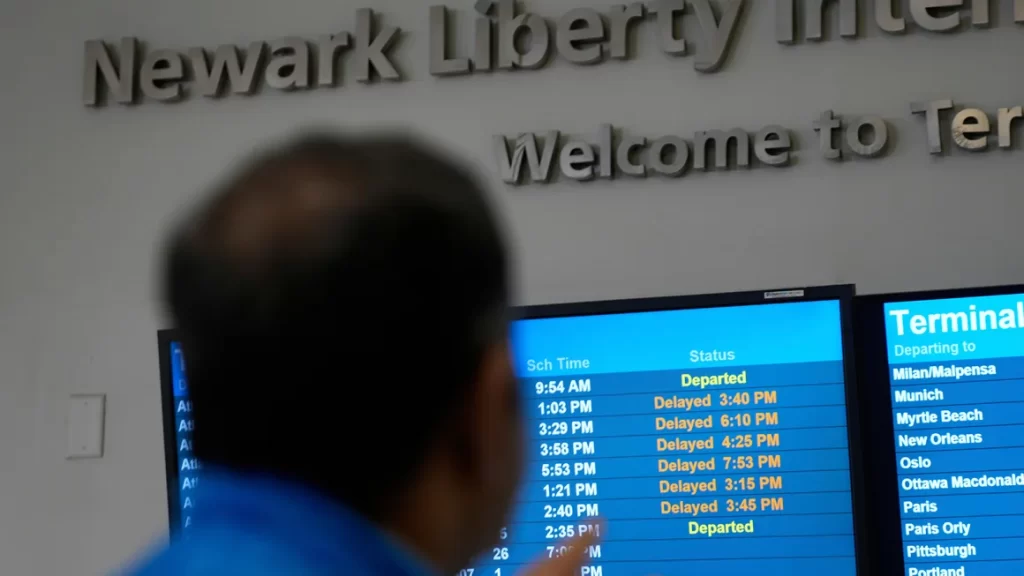Air traffic controllers in Philadelphia had been guiding planes to Newark Liberty International Airport in New Jersey last week when communications suddenly crashed.
“Approach, are you there?” one pilot asked the controller.
The controller had stopped responding.
United Airlines Flight 1951, flying from New Orleans to the Newark hub, tried to radio the controller five times before finally getting a response.
“United 1951, how do you hear me?” the controller asks, according to air traffic control conversations recorded by the website LiveATC.net.
“I got you loud and clear, United 1951,” the pilot responds.
Those 30 seconds of silence when communication went down ultimately cascaded into a weeklong meltdown at Newark, one of the nation’s largest airports. It resulted in delays and cancellations for thousands of customers, controllers taking leave for trauma, and renewed scrutiny on an outdated air traffic control system.
The chaos also highlighted the challenges of an understaffed system, the latest incident in an already turbulent year for aviation that included a deadly collision between a passenger jet and US army helicopter.
‘I don’t know where you are’
Transportation Secretary Sean Duffy told Fox News Monday controllers had lost the primary communication, and the backup line did not immediately take over. Audio obtained by CNN shows the tense moments from the afternoon of April 28.
Related article
What we know about the massive staffing shortage that has caused days of major delays at Newark Airport
“United (flight) 674, radar contact lost,” a controller tells a pilot flying to Newark from Charleston, South Carolina. “We lost our radar so just stay on the arrival and maintain 6000 (feet).”
The same flight, traveling at hundreds of miles an hour, returns to the radar but does not show up in an accurate position.
The connectivity between Federal Aviation Administration radar and the frequencies that air traffic controllers use to manage planes at the airport “completely failed,” a source with knowledge of the situation said. Without radar, another approach controller told the pilot of a smaller aircraft to rely on towers for clearance.
“Do I have bravo clearance?” the pilot asks. Bravo clearance is permission to enter into the airspace surrounding a larger airport, like Newark Liberty.
“No, you do not have a bravo clearance. We lost our radar and it’s not working correctly. Radar service terminates… If you want a bravo clearance, you can just call the tower when you get closer,” the controller said.
About 15 to 20 flights were being controlled by Newark Liberty approach controllers when communication and radar went down on April 28, according to an analysis by flight tracking site Flightradar24.
Related article
The US is struggling to hire air traffic controllers. A surprising age limit and grueling schedules could fuel the problem
The number is based on the altitude of aircraft bound for and departing Newark and audio from the approach radio frequency, Ian Petchenik, the director of communications for the site, tells CNN.
No crashes occurred, but at least five FAA employees took 45 days of trauma leave afterward.
Aviation analyst Miles O’Brien told CNN that the controllers did what they could with a potentially dangerous situation.
“I think, as I always say, that the controllers, the individuals who run this system daily, perform quiet heroic acts, in spite of a system that is built to set them up for failure. I believe in those people doing their job, but there’s only so much stress they can take,” O’Brien said.
The incident has compounded existing staffing shortages and equipment failures and contributed to frustrating hourslong delays for passengers, Duffy told Fox News.
A CNN analysis of FAA airspace advisories shows at least 14 straight days of FAA-imposed delays for flights to or from Newark.
More than 150 flights into or out of the airport on Monday were canceled, with more than 350 flights delayed, according to the flight tracking website FlightAware. And on Tuesday, the FAA announced a ground delay for inbound flights at the airport, causing further delays.
The FAA has indicated it expects delays at the airport to continue due to the staffing shortages. Duffy added that authorities will have to slow traffic at Newark before restoring full capacity.
A traumatic event
The current shortage of air traffic controllers is nearly the worst in 30 years, said the National Air Traffic Controllers Association, which represents 10,800 certified air traffic controllers across the country.
The control facility responsible for traffic at Newark has been “chronically understaffed for years,” United Airlines CEO Scott Kirby said in a Friday message addressing the delays. He also said the shortage was compounded by over 20% of FAA controllers who “walked off the job” at Newark Airport last week.
Related article
Air traffic controllers lost communication with Newark planes – leading to widespread delays after they took leave for trauma
The controllers’ union said workers did not “walk off the job.”
“The controllers didn’t just walk off the job, they were traumatized, their equipment failed,” the source with knowledge of the situation said. “It’s written in the regulations if they experience a traumatic event — they can take time off to go see psychiatrist. The people working that day did that.”
But filling those empty positions is not an issue that can be sorted overnight, according to the FAA.
New air traffic control applicants must be younger than 31 years old so they can work the mandatory 20 or 25 years needed to qualify



